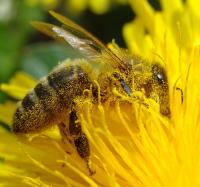Pollination
 Insects are a key source of pollination for plants
Insects are a key source of pollination for plantsPollination is the process of transferring pollen from the male to the female part of the flower for the plant's reproduction.
At this time of year, our practical activities in the garden are limited, so it is a good time to plan ahead and also build our knowledge of plants and gardening. I have always been interested in the process of pollination and the development of a flower into a fruit.
The term ‘pollen’ is defined as:
‘The fine dustlike grains discharged from the male part of a flower, each containing the gametes that fertilize the female ovule.’ - The Oxford English Reference Dictionary 1996.
The process of pollination is therefore the successful transfer of pollen from the anther on the male flower to the stigma on the female flower.
The primary function of a flower is sexual reproduction. The male nuclei are contained within the pollen grain; discharged by the anther. The female nuclei are contained within the ovule.
The process of pollination can be split into two groups:
- Self-pollination is when the pollination process takes place between an anther and stigma on the same flower.
- Cross-pollination is when the pollination takes place the anther and stigma on different flowers.
Cross-Pollination
Whilst cross-pollination could occur between two different flowers on the same plant people who breed plants prefer to use different plants. This ensures the introduction of variation into the resulting offspring.
The most important and most common methods of cross-pollination are insects and wind.
Flowers that are pollinated by wind are usually small and often green in colour. They are usually unscented and produce no nectar. However, wind-pollinated flowers do produce large amounts of pollen. Willow (Salix) is an example of a wind pollinated plant.
Wind pollinated plants usually produce much more pollen than flowers pollinated by insects. Successful pollination is obviously very weather dependant, therefore these plants produce more pollen to increase their chances of successful pollination.
Flowers used for wind pollination also have stamens protruding well above the other flower parts to catch the wind and release their pollen into the air.
Flowers that are pollinated by insects have brightly coloured petals that are used to attract insects. Nectar is produced to feed and reward the insect for visiting the flower. When the insect visits the flower, pollen grains stick to their bodies and are transferred to the next flower. Bees are amongst the most important insect pollinators.
In tropical regions of the world pollination may also be assisted by other animals such as hummingbirds and bats.
When the pollen grain has been transferred by wind, insect or other method (skilled plant breeders can pollinate plants by hand) to the stigma on the female flower it produces a pollen tube that grows down through the style of the female flower into the ovule. Male and female nuclei then fertilize inside the ovule, the end result being the embryo of the seed. It is the ovary that surrounds the ovule that develops into a fruit.
Fruit Tree Pollination
One group of plants particularly important to the gardener and the commercial grower are the fruit trees. The issue of pollination is primary if a crop of fruit is to be harvested. Some fruit trees are self fertile but many fruit trees need pollen from a different fruit tree cultivar to pollinate their own flowers successfully.
The ‘Bramley’s Seedling’ apple tree is unusual amongst apple cultivars because it has three times the number of chromosomes of a normal fruit tree and therefore requires the pollen from two additional cultivars to pollinate it’s flowers.
A reputable grower of fruit trees will offer expert advice on which compatible cultivars are required to pollinate your chosen fruit tree.
Example of Fruit tree supplier offering advice about Pollination
For cross-pollination to occur between cultivars both of the plants concerned need to be in flower at the same time. Fruit trees tend to crop more heavily and develop better quality fruits when they have a pollination partner. In many areas of the U.K. there are so many apple trees around in private gardens that you don’t need to plant the necessary pollinator for your selected fruit tree because the cultivar required is probably already in the neighbourhood.
Growing fruit in your own garden is one of the most rewarding aspects of gardening. Understand pollination and you will greatly increase your chances of a bumper crop.
Picture by Nicolas Guérin
Filed under DIY Gardening Jobs.
